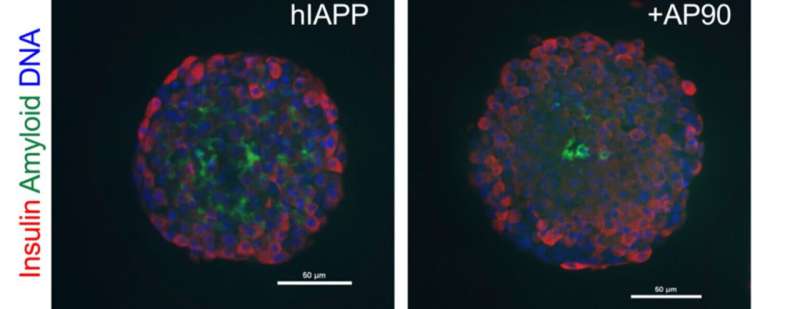This article has been reviewed according to Science X's editorial process and policies. Editors have highlighted the following attributes while ensuring the content's credibility:
fact-checked
trusted source
proofread
Q&A: How a potential treatment for Alzheimer's disease could also work for type 2 diabetes

Of the 38 million Americans who have diabetes, at least 90% have type 2, according to the Centers for Disease Control and Prevention. Type 2 diabetes occurs over time and is characterized by a loss of the cells in the pancreas that make the hormone insulin, which helps the body manage sugar.
These cells make another protein, called islet amyloid polypeptide or IAPP, which has been found clumped together in many type 2 diabetes patients. The formation of IAPP clusters is comparable to how a protein in the brains of Alzheimer's disease patients sticks together to eventually form the signature plaques associated with that disease.
Researchers at the University of Washington have demonstrated more similarities between IAPP clusters and those in Alzheimer's. The team previously showed that a synthetic peptide can block the formation of small, toxic Alzheimer's protein clusters. Now, in a recently published paper in Protein Science, the researchers have used a similar peptide to block the formation of IAPP clusters.
UW News asked co-senior author Valerie Daggett, a UW professor of bioengineering and faculty member in the UW Molecular Engineering & Sciences Institute, for details about protein aggregation and how these synthetic peptides work.
Alzheimer's and type 2 diabetes are part of a family of amyloid diseases that are characterized by having proteins that cluster together. What's happening?
There are over 50 of these amyloid diseases, and they start out with their respective proteins in their biologically active, good form. But then the proteins start changing structure and globbing together. These aggregates can be different sizes. They can have different underlying structures and different effects on the cells around them.
Early in the process there are smaller clusters, which are toxic, and they set off all kinds of problems. This leads to a very complicated disease because lots of other things go awry in response to these toxic clusters. Over time, these clusters combine to form non-toxic structures: longer strands and finally large deposits, such as the Alzheimer's plaques.
Many people know that protein aggregation plays a role in neurodegenerative diseases, such as Alzheimer's disease. Can you describe what's happening here?
In the case of Alzheimer's, these small, toxic protein clusters are running around the brain attacking neurons and then over time there's enough damage that we start to see symptoms. By the time these clusters have combined to form the non-toxic plaques, there's already been a lot of damage. It becomes similar to trying to treat stage 4 cancer. That's why we want to get in early.
What's happening with type 2 diabetes?
It's similar, except it's happening in the pancreas instead of the brain. In healthy people, cells in the pancreas, called beta cells, secrete IAPP along with insulin. The normal, active form of IAPP helps with metabolism maintenance. But when IAPP changes shape, it starts to form these toxic clusters and then it starts attacking the beta cells. And these clusters are equal-opportunity toxins. We and many others have shown that you can put them on different cell types and they will kill the cells.
In this paper, you show that the IAPP clusters go through an 'alpha sheet' phase. What does this mean and why is it significant?
We've been looking at these amyloid systems for a long time and we started seeing this weird protein structure. It's like every other one of the protein building blocks, called amino acids, has had this crankshaft motion on it. Half of them are rotated the wrong way.
At first we thought, "That's got to be an artifact. Nobody discovers a new structure." But we've since shown that this "alpha sheet" structure is real. And proteins in all the amyloid systems we've looked at—14 now including type 2 diabetes—form these alpha sheet structures when they're in these small, toxic clusters. No one had seen that for IAPP before this paper.
Also in this paper, you showed that a synthetic peptide was able to bind and neutralize the toxic IAPP clusters and keep beta cells alive. What's special about this peptide and how does it work?
Previously, we designed synthetic peptides to bind to the toxic protein clusters in Alzheimer's disease. The idea here is for these peptides to take these clusters out of commission before they can wreak havoc on the cells. The peptide we made also forms an alpha sheet structure, but it is not toxic to the cells. It binds really tightly to the clusters, and we're currently studying what happens to the clusters after it binds.
In this paper, we showed that our synthetic peptides also work against the toxic IAPP clusters, which means this could be a potential therapeutic in the future.
Type 2 diabetes is the most prevalent amyloid disease—it affects half a billion people worldwide. A lot of people associate type 2 diabetes treatment with changing lifestyle measures, but that doesn't work for everyone. A drug that could help minimize the damage IAPP does to the pancreas could be really helpful.
More information: Cheng‐Chieh Hsu et al, Human islet amyloid polypeptide‐induced β‐cell cytotoxicity is linked to formation of α‐sheet structure, Protein Science (2023). DOI: 10.1002/pro.4854




















